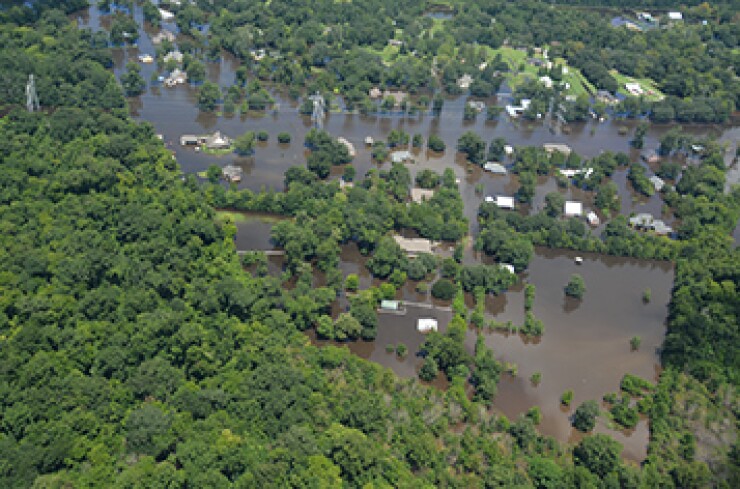
BRADENTON, Fla. - Federal aid will alleviate financial challenges for southern Louisiana parishes affected by this month's flooding, but the disaster remains a credit negative for the state and local governments, Moody's Investors Service said Monday.
Unbudgeted cleanup, emergency services, sheltering and other expenses could pressure liquidity while local governments wait for federal and state reimbursements, said analyst Sarah Jensen.
Moody's rates the state of Louisiana, as well as 13 issuers in affected parishes.
"We have communicated with all issuers with debt-service payments due on [Sept. 1] and do not expect an interruption in near-term debt service payments," she said.
On Aug. 16, President Barack Obama signed a major federal emergency disaster declaration for 20 Louisiana parishes, some of which received more than 20 inches of rain.
The declaration makes federal aid available to assist in state and local response efforts and authorizes the Federal Emergency Management Agency to coordinate relief and cleanup efforts.
The emergency aid supplements state and local expenditures, including those for debris removal and emergency protective measures, and traditionally covers approximately 75% of recovery costs.
Gov. John Bel Edwards said he requested additional assistance from Obama, who toured flood ravaged areas on Aug. 23, including a reduction to 10% from 25% as Louisiana's share of cost recovery expenses.
Edwards said more than 100,000 homes were damaged or destroyed, in addition to state-owned buildings, roads and bridges that were damaged in 26 parishes, including the 20 in the federal disaster declaration.
The most recent audits of most issuers that it rates in the affected parishes had operating cash that exceeded 20% of operations and a majority had cash that exceeded 50% of operations, according to Moody's.
The liquidity will mitigate near-term risks due to declining revenues, especially in property taxes and sales taxes - the primary two revenue streams for most local governments, Moody's said.
The Louisiana Tax Commission has instructed local assessors to provide a timeline by the end of August for reassessing damaged properties.
"Although local governments may see near-term declines in assessed values, rebuilding efforts, which will benefit from FEMA aid, will help assessed values stabilize over the longer term," Jensen said.
Sales taxes could also experience a temporary slump in receipts during the disaster period, although recovery efforts likely will lead to higher sales tax collections as rebuilding efforts drive taxable purchases.
"Should FEMA and state reimbursements to local governments fall short of our expectations, there would be a more significant credit-negative effect on the affected local governments," Jensen said.
On Friday, state Treasurer John Kennedy issued a press release stating that residents in presidential disaster areas impacted by floods that occurred in the state during March and August can file for a refund of state sales taxes paid on personal property that was destroyed.
The state will reimburse state sales taxes paid on any portion of destroyed property not reimbursed by insurance or disaster relief, Kennedy said, adding that the state can waive documentation if receipts are not available.
Residents have three years to file claims with the Louisiana Department of Revenue.
On Monday, Cumberland Advisors said the effect of the flooding disaster on the state's credit quality remains to be seen.
"There is a very good chance that the flooding will exacerbate the state's cash crunch," wrote Patricia Healy, senior vice president of research, and fixed income director, John Mousseau.
Under former Gov. Bobby Jindal the state eliminated a $1 billion surplus and drew down fund balances, they said. The state also dipped into the rainy day fund and used other "one shots" measures to balance the budget.
"Cumberland has had a negative view of the state because of Louisiana's continued budgetary and economic stress triggered by the decline in oil prices that has resulted in the loss of oil and gas employment," Healy and Mousseau said.
The firm holds about $16 million of Louisiana paper, excluding pre-refunded bonds. About $9 million is insured. Some investments are in areas affected by the flooding, and those credits will be reviewed, they said.
The state of Louisiana's general obligation bonds are rated AA by S&P Global Ratings and Aa3 by Moody's. Both have negative outlooks.
"We do not think either ratings agency will take immediate action," Healy and Mousseau said. "However, we remain wary of a state where finances are tenuous, borrowable resources are dwindling, and the brunt of the hurricane season is still to come."
The Atlantic hurricane season runs from June through the end of November, with August and September usually being the most active months.





